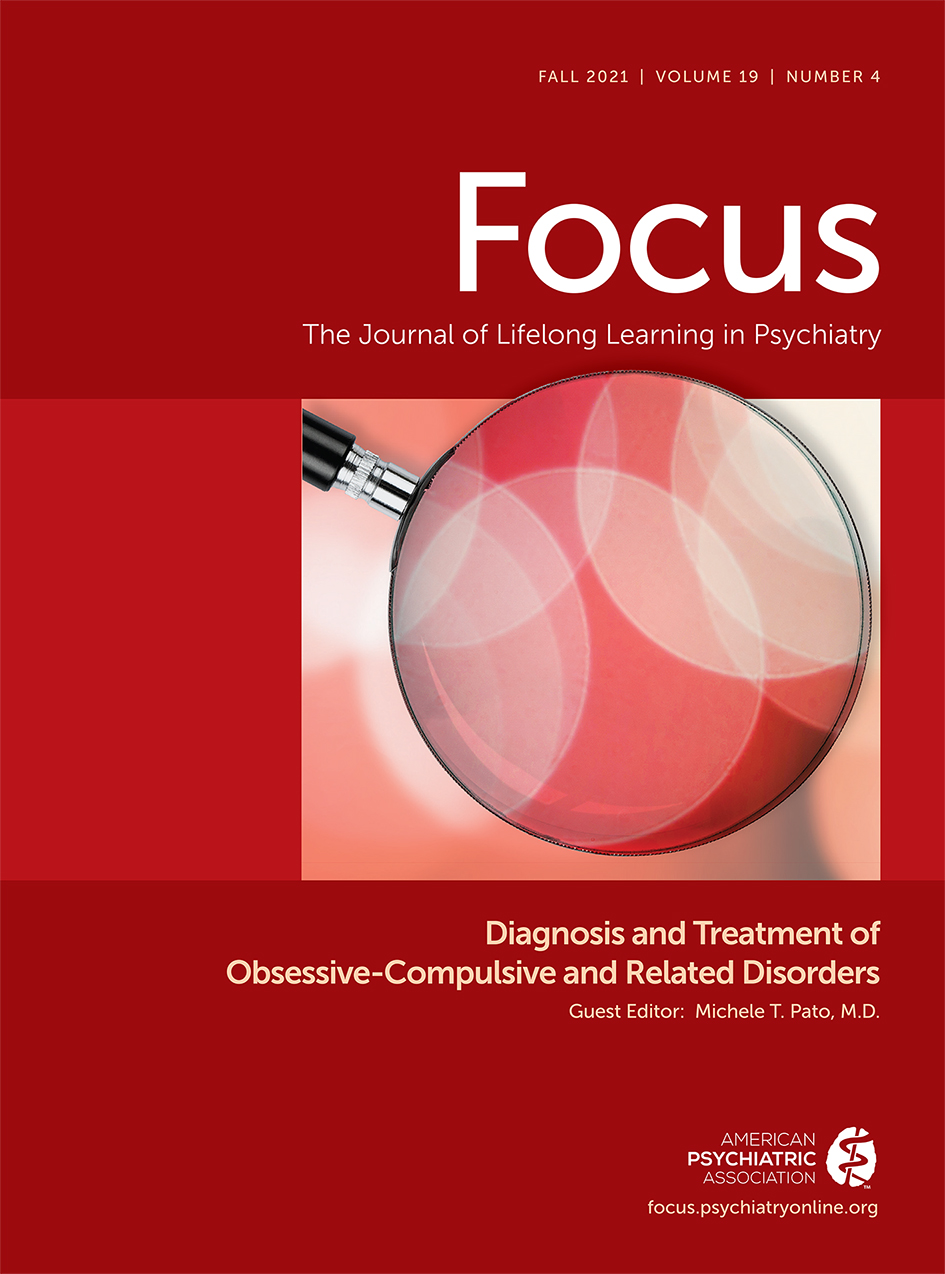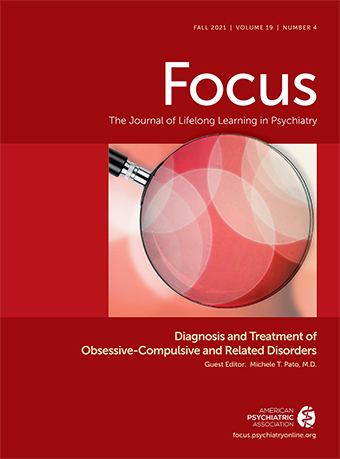Family factors that may predict or moderate youths’ symptom improvement during treatment have been extensively studied. In a meta-analysis with 37 studies, McGrath and Abbott (
76) examined the effect of family-based interventions on OCD symptoms and family factor outcomes for pediatric OCD. Their findings add further support to preliminary results in the literature that specific family factors, such as family cohesion, conflict, and parental blame of the youth, may affect response to treatment for youngsters with OCD (
77). In general, family accommodation, negative family dynamics, higher conflict, poor cohesion, and parental blame predict poorer treatment outcome (
1,
78).
FA.
Another family factor that affects treatment outcome is family accommodation (FA). As with adults, FA is a salient feature of pediatric OCD. Studies report high levels of accommodating behaviors by family members of children with OCD, with a large percentage of families (60%−96% of family members) engaging in either modifying family routines or participating in a youth’s rituals (
1). In a study by Lebowitz et al. (
79), FA was found to be highly prevalent in both pediatric anxiety disorders and OCD, with no significant group differences in levels of participation, modification, or total accommodation. The importance of this concept is evident by the interest in FA and its impact on treatment as outlined below.
The most common FAs consist of providing reassurance, participating in rituals, and assisting in avoidance of feared situations or objects (
80). OCD symptom severity, functional impairment, children’s internalizing and externalizing symptoms, and parental psychopathology (maternal depression and anxiety) have been associated with FA of children with OCD (
35,
78). FA is associated with increased OCD symptom severity because it causes greater family dysfunction and negative dynamics and has an impact on family life. As well, higher levels of FA, low insight, and OCD symptom severity have been linked to poorer in-session compliance and willingness to participate in treatment (
1).
Higher levels of accommodation are related to poorer treatment outcome, irrespective of treatment modality (CBT or medication) (
62,
81). Peris and colleagues (
77) found that reductions in FA may account for changes in clinical symptoms of youths with OCD in families with poor functioning. In contrast, Torp et al. (
68), in examining the NordLOTS data, found no relationship between FA and outcome; however, the high amount of family involvement in that study may have positively influenced the family environment and inadvertently addressed the FA. In a large (N=41 studies) meta-analysis, Wu et al. (
62) found a medium-sized correlation between FA and OCD symptom severity (consistent with the effect size found by Strauss et al.) (
82), suggesting that increased OCD symptoms are associated with higher levels of accommodating behaviors. Monzani et al.’s (
83) post hoc analyses supported this relationship in a study of maternal and paternal FA behaviors. For an in-depth review of FA (up until 2015), the interested reader is referred to Lebowitz et al. (
81)
Storch et al. (
80) found that FA mediated the relationship between OCD symptom severity and parent-rated child functional impairment and that children reported greater impairment in school when families accommodated their symptoms. Stewart et al. (
84), in a multisite study, found that FA predicted family impairment. They found that 50% of mothers, 30% of fathers, and 70% of youths reported daily impacts on their functioning in occupation and/or school and feelings of frustration-anger and stress-anxiety. These results are consistent with higher levels of distress associated with the need to accommodate in a study comparing youths with pediatric anxiety and OCD to those without the conditions (
79).
Children’s comorbid internalizing and externalizing symptoms have been found to predict negative outcomes for CBT treatment (
68), possibly because of parental accommodation of the child’s OCD symptoms. In studies of FA among pediatric samples, comorbid anxiety disorders moderated the relationship between OCD symptom severity and FA (
78) as well as the relationship between parent anxiety and FA (
85). Family accommodation has been associated with increased parental anxiety symptoms as well as with treatment outcomes among children (
78,
81). In a recent study, Monzani et al. (
83) found a relationship between FA and youth emotional and behavioral difficulties as well as parental anxiety and distress, regardless of whether it was the mother or father accommodating. Also, when both parents displayed FA, OCD severity, functional impairment, child emotional and behavioral difficulties, and parent psychopathology were higher compared with when either one parent or neither parent made accommodations.
In addition, family cohesion and externalizing symptoms predicted FA (
78), often because coercive or disruptive behaviors contribute to increased levels of FA (
36). Externalizing symptoms and emotional dysregulation (e.g., rage) among youths with OCD are associated with higher levels of family accommodation. In a recent study, McKenzie et al. (
86) found that parental report of children's emotional lability was significantly and positively correlated with children’s externalizing symptoms and family accommodation. These results support the idea that parents seem more likely to give in to accommodating behaviors in the presence of the youth’s emotional dysregulation. To resist giving in and accommodating a child’s OCD, the parent or family member needs to be able to tolerate the child’s distress. In the Pediatric Obsessive-Compulsive Disorder Treatment Study (POTS) for Young Children sample, Selles et al. (
87) found preliminary evidence that child and parent distress tolerance significantly improved with treatment. Interestingly, fathers’ baseline distress tolerance was significantly related to symptom improvement, suggesting the importance of studying paternal FA.
In a large (N=209) quantitative study, Monzani et al. (
83) compared maternal and paternal FA and how FA affected children’s OCD symptoms and treatment. Consistent with prior research
, both mothers and fathers accommodate their child’s OCD symptoms with high daily frequency (55%).
FA interferes with treatment goals of CBT and ERP by reinforcing the fear and avoidance behaviors, thus FA is an important focus for intervention. Lebowitz et al. (
88) demonstrated the effectiveness of addressing FA in a comparison of CBT with their 10- to 12-week parent-only intervention for childhood anxiety and OCD (Supportive Parenting for Anxious Childhood Emotions [(SPACE]). Seven-to-14-year-olds were randomly assigned to either SPACE (with no direct child-therapist contact) or CBT (with no parent treatment). Regardless of treatment modality, FA and parenting stress were significantly reduced; however, there was a significantly greater FA reduction following SPACE compared with CBT. These results suggest parental change alone can reduce child OCD and anxiety and may be effective in situations where children refuse treatment. Further RCTs investigating this program’s effectiveness on pediatric OCD are warranted.

